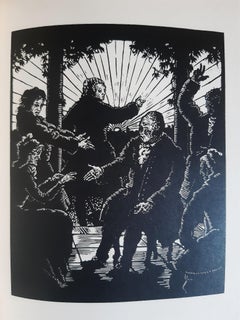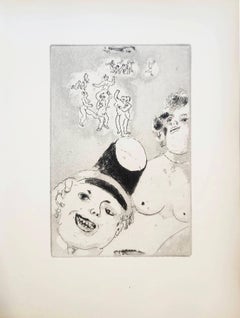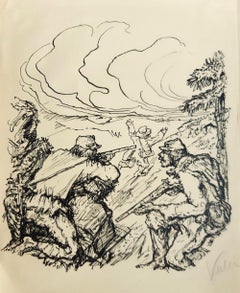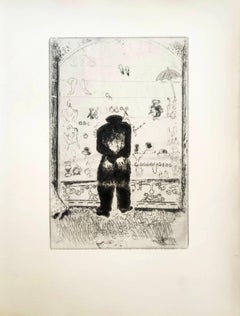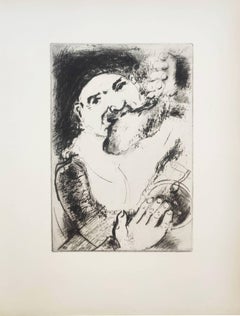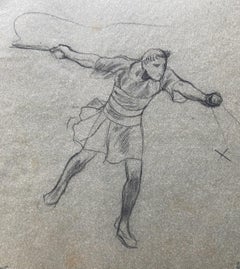Symbolist Art
to
106
573
103
158
44
74
Overall Width
to
Overall Height
to
2
108
641
204
27
103
111
93
13
12
24
18
49
15
114,402
65,133
54,968
27,068
14,914
9,377
6,543
5,788
4,194
3,054
2,584
2,329
2,247
718
604
265
65
567
356
234
182
181
109
101
58
48
48
46
38
33
31
26
25
20
20
20
19
258
224
161
159
134
96
44
38
37
34
132
434
549
247
Style: Symbolist
Candid Oder der Optimismu - Original Rare Book Illustrated by Max Unold - 1913
Located in Roma, IT
Candid oder der optimismus is an original modern rare book written by Voltaire and illustrated by Max Unold (Memmingen, 1885 - Munich, 1964) in 1913.
Original Edition.
800 Numbere...
Category
1910s Symbolist Art
Materials
Paper, Lithograph
Le Sept Péchés Capitaux
By Marc Chagall
Located in OPOLE, PL
Marc Chagall (1887-1985) - Le Sept Péchés Capitaux
Etching from 1925.
Edition of 300 proofs.
Dimensions of work: 25 x 19.5 cm.
Publisher: Tériade, Paris.
Reference: Kornfeld 47....
Category
1920s Symbolist Art
Materials
Etching
$744 Sale Price
30% Off
Two Soldiers - Original Lithograph by A. Kubin - 1933
By Alfred Kubin
Located in Roma, IT
Zwei Soldaten is an original lithograph on paper, realized by Alfred Kubin in 1933, Hand-signed in pencil.
Sheet dimension: 27,5 x 22,5cm.
In very good conditions.
References:
Arn...
Category
1930s Symbolist Art
Materials
Lithograph
Le Sept Péchés Capitaux
By Marc Chagall
Located in OPOLE, PL
Marc Chagall (1887-1985) - Le Sept Péchés Capitaux
Etching from 1925.
Edition of 300 proofs.
Dimensions of work: 25 x 19.5 cm.
Publisher: Tériade, Paris.
Reference: Kornfeld 47....
Category
1920s Symbolist Art
Materials
Etching
$744 Sale Price
30% Off
Le Sept Péchés Capitaux
By Marc Chagall
Located in OPOLE, PL
Marc Chagall (1887-1985) - Le Sept Péchés Capitaux
Etching from 1925.
Edition of 300 proofs.
Dimensions of work: 25 x 19.5 cm.
Publisher: Tériade, Paris.
Reference: Kornfeld 47....
Category
1920s Symbolist Art
Materials
Etching
$744 Sale Price
30% Off
G. A. Rochegrosse (1859-1938) , Study for "Le Cocher" original drawing
Located in Paris, FR
Georges Antoine Rochegrosse (1859-1938)
Study for "Le Cocher"
carbon pencil on thin paper
14.5 x 13 cm
In good condition
Framed : 36.7 x 31 cm
Provenance: Estate of the artist and...
Category
1910s Symbolist Art
Materials
Carbon Pencil
Les Aveugles ( The Blind )
Located in Paonia, CO
Henri DeGroux (1866-1930) was a Belgian Symbolist painter, sculptor and lithographer. He was known for his allegorical, religious and historical subject matter. He became an inspired...
Category
1910s Symbolist Art
Materials
Lithograph
Ambulkance
Located in Paonia, CO
Henri DeGroux (1866-1930) was a Belgian Symbolist painter, sculptor and lithographer. He was known for his allegorical, religious and historical subject matter. He became an inspired...
Category
1910s Symbolist Art
Materials
Lithograph
Hercules and the Lion (Apologies to Rubens) classical image, male figure
By Tom Bennett
Located in Brooklyn, NY
An expressionist homage to Rubens. Active, colorful take on an allegorical painting based on Greek Mythology. Active movement, aggressive brush strokes combine for a powerful and mil...
Category
2010s Symbolist Art
Materials
Oil
Carthage
By Théodore Rivière
Located in PARIS, FR
"Carthage"
also known as "Salammbô at Mathô, I Love You! I Love You"
by Théodore RIVIERE (1857-1912)
A bronze group with a nuanced greenish brown patina
Signed on the base " Théodor...
Category
Late 19th Century Symbolist Art
Materials
Bronze
"Ô de la nuit", Night Blue Forest Abstract Landscape Oil Painting
Located in Clermont-Ferrand, Auvergne-Rhône-Alpes
This large artwork figures a bamboo forest in the night.
The artist impasto technique is light, with textured painting and a few small reliefs.
This artwork is not framed.
Françoi...
Category
Late 20th Century Symbolist Art
Materials
Canvas, Oil
G. A. Rochegrosse (1859-1938) Studies of men, original drawing
Located in Paris, FR
Georges Antoine Rochegrosse (1859-1938)
Studies of men,
Pencil on paper
23 x 41.5 cm
Signed lower right
In good condition
In a modern mount 41 x 52.5 cm
Provenance: Estate of the...
Category
1910s Symbolist Art
Materials
Carbon Pencil
La Muse Du Lac - Symbolist Figure in Landscape Oil Painting by Alphonse Osbert
Located in Marlow, Buckinghamshire
Signed and dated symbolist figure in landscape oil on board by French painter Alphonse Osbert. The piece depicts a blonde woman in a full length purple...
Category
Early 20th Century Symbolist Art
Materials
Board, Oil
Le rêve brisé
Located in Saint-Ouen-sur-Seine, FR
In this enchanting painting by Adolf Gudfast (Gotthard) Werner, entitled "The Broken Dream", a young shepherd rests melancholically beside his faithful dog, facing a broken vase from...
Category
1870s Symbolist Art
Materials
Oil
Fool's Paradise Movie Costume Sketch Cecil B. DeMille - Classic Hollywood
Located in Miami, FL
Natacha Rambova imaginatively conceives and sketches a costume for Cecil B. DeMille's 1921 movie Fool's Paradise: Paramount. Rendered in Gouache, watercolor, pencil, and metallic s...
Category
1920s Symbolist Art
Materials
Silver, Bronze
Illustration for Hésperus by Carlos Schwabe, Symbolist fantasy aquarelle, 1904
Located in Chicago, IL
Lithograph from Carlos Schwabe’s series of hand-colored Symbolist fantasy illustrations for Catulle Mendès’ Hésperus, published in 1904 by Société de pr...
Category
Early 1900s Symbolist Art
Materials
Paper, Aquatint
In Schnee - Etching by Fritz Schwimbeck - 1918
Located in Roma, IT
Etching realized by Fritz Schwimbeck in 1918.
Edition of 125 realized in Munich on mulberry paper.
Hand signed in pencil.
Category
1910s Symbolist Art
Materials
Etching
#2209F By David Jones, affordable, ink paper, nude, black and white
Located in Deddington, GB
original
Ink on Paper
Image size: H:41.5 cm x W:29.5 cm
Complete Size of Unframed Work: H:41.5 cm x W:29.5 cm x D:0.1cm
Sold Unframed
Please note that insitu images are purely an indication of how a piece may look
#2209F is an original meditative life drawing by David Jones. A technique the artist has developed to create these beautifully composed and minimal figurative...
Category
2010s Symbolist Art
Materials
Ink
Cross - as the unity of the world. 2009, oil on canvas, 83x67 cm
Located in Riga, LV
Cross - as the unity of the world. 2009, oil on canvas, 83x67 cm
Category
Early 2000s Symbolist Art
Materials
Canvas, Oil
$1,720 Sale Price
20% Off
Bayros-Mappe III - Héliogravure by Fraz von Bayros - 1913
Located in Roma, IT
Héliogravure on japanese paper realized by Fraz von Bayros in 1913 for Ex Libris Verlag K. Th. Senger, Munich.
Mounted on passepartout. Edition of 260, hand signed in pencil by the ...
Category
1910s Symbolist Art
Materials
Photogravure
Death of the Gravedigger by Carlos Schwabe, Symbolist lithograph, c. 1900
Located in Chicago, IL
Lithograph of Symbolist painter Carlos Schwabe’s oil painting La mort du fossoyeur (The Death of the Gravedigger), 1895, published c. 1900 in Art et déc...
Category
Early 1900s Symbolist Art
Materials
Paper, Lithograph
Huge French 1930's Signed Oil Classical Roman Fountain Statue Floral Scene 1933
Located in Cirencester, Gloucestershire
The Roman Statue
by Gabriel Jules-Charles Girodon (French, 1884–1941) *see notes below
signed and dated
oil painting on canvas, framed
framed: 38 x 47 inches
canvas: 36 x 44 inches...
Category
Early 20th Century Symbolist Art
Materials
Oil
André Eugène Costilhes (1865-1940) A young woman sewing, drawing
Located in Paris, FR
André Eugène Costilhes (1865-1940)
A young woman sewing
bears the stamp of the studio of André Eugène Costilhes in the lower right-hand corner
pencil on paper
30.5 x 20 cm
In quit...
Category
Early 1900s Symbolist Art
Materials
Pencil
Fine Antique French Oil Painting Sirens and Cupid Dancing along the Seashore
Located in Cirencester, Gloucestershire
Artist/ School: Adolphe Lalyre (French, 1848-1933) signed
Title: Sirens and Cupid dancing along the seashore
Medium: signed oil on canvas, unframed.
canvas: 22.75 x 28 inches
Pr...
Category
19th Century Symbolist Art
Materials
Oil
Memorial - Abstract 9/11 Tribute
Located in Soquel, CA
World Trade Center memorial artwork by Marc Foster Grant (American, b. 1947). This piece is composed of multiple layers of quotes relating to the 9/11 attacks on the World Trade Cent...
Category
Early 2000s Symbolist Art
Materials
Acrylic, Handmade Paper
$1,280 Sale Price
20% Off
The DNA Goddess
By Janet Morgan
Located in Brooklyn, NY
Watercolor, mixed media, using resists. This is from the God and Goddess Series, Morgan's Supreme Being, nearly 200 deities both new and new takes on tra...
Category
2010s Symbolist Art
Materials
Mixed Media, Watercolor, Archival Paper
Casiopee - Painting Green Grey Brown Orange Yellow White Black Sand
Located in Sofia, BG
"Casiopee" is a painting by Maestro Edele Bessy - MABILLOT GRANDJEAN GENEVIEVE
The painting is unframed.
Her paintings bring emotion of happiness, love, energy and beauty represented by the vast creative power of her talent.”
Dear art lovers,
if you like the art of maestro Bessy, please click the link to follow this artist and art gallery Snow Pearl to discover all our artists and beautiful artworks.
Thank you so much! we appreciate your interest to our work.
Maestro Edele Bessy was born on August 7, 1946. Self-taught painter since 1982. At first she mainly worked in miniature on ivory, which she then abandoned in favor of oil painting.
New beings appear unconsciously on his canvases taking on the dimension of a wandering crowd, mostly women whose eyes arise and challenge us with ever so much acuity.
Maestro Bessy paints in a very personal, constantly evolving style.
Maestro MABILLOT GRANDJEAN GENEVIEVE - ADELE BESSY
Awards :
Prix de Peinture du Salon de Beauchamp 2023
Médaille du Conseil Départemental de Bourg la Reine 2023
Prix de peinture Salon des Amis des Arts de Chaville 2022
Prix de peinture Salon des beaux-arts de Boulogne-Billancourt 2022
2ème Prix de Peinture Salon de Chablis 2022
Prix de la ville Salon du SPAM Pontoise 2021
Grand Prix de Peinture de SEMEAC 2021
Prix du Jury indépendant Etampes 2021
Prix du conseiller Départemental Salon de Croissy sur seine 2019
Médaille de la ville de St Maurice 2019
Prix du Jury Gagny 2019
1er Prix de peinture Salon des Artistes indépendants Normands 2018
Prix du Jury Salon de Champagne sur Oise 2018
2ème Prix de Peinture Salon de Bois Colombe 2018
Diplôme d'Honneur et Médaille de la ville de Livry-Gargan2017
Prix Univers des Arts Salon de Thionville 2017
Prix de peinture Salon du Plessis Bouchard 2017
Médaille d'Or Salon de Taverny 2017
Prix de Peinture Salon de Sannois 2016
Médaille d’Or Salon de Bondy 2016
Prix de la peinture à l’Huile Ste Maure de Touraine 2016
2ème Prix de Peinture Pont des Arts Vire Normandie 2016
Médaille d’Argent Salon de Cormeilles en Parisis 2016
Prix de Peinture Salon de Guyancourt 2015
Prix du Public Coye la Forêt 2015
Grand Prix du Salon de Roissy en France 2015
L’école de la Loire Prix de Composition Fantastique 2015
L’école de la Loire Grand Prix du Conseil Général 2015
Prix du Public Salon de Plaisir 2014
Prix du Jury Salon de Coye la Forêt 2014
Prix du Bateau Atelier Salon de Bennecourt 2014
Prix du Jury Salon d’Etampes 2014
1er Prix de Peinture de la Municipalité de Taverny 2014
1er Médaille d’Or Salon de Vittel 2014
Prix de la Municipalité de Viarmes 2013
Prix du Public Salon de Gouvieux 2013
Prix de Peinture Salon de Magny en Vexin...
Category
2010s Symbolist Art
Materials
Canvas, Oil
Der Büsser - Original Woodcut by J.J. Weber - 1898
Located in Roma, IT
Image dimensions: 34 x 19 cm.
Der Büsser is an original print, realized in 1898.
Black and white xylograph on applied Japon paper.
Good conditions except for yellowing of paper (especially along the margins), and little stains on lower margin.
The print was realized by Johann Jacob Weber and it's part of the series Meisterwerke der Holzschneidekunst (original title: SECHZEHN HOLZSCHNITTE NACH GEMÄLDEN ARNOLD BÖCKLIN...
Category
1890s Symbolist Art
Materials
Woodcut
Ghosts of New York 2, monochromatic dramatic city-scape surrealistic undertones
By Tom Bennett
Located in Brooklyn, NY
One of a series of oil-based monotypes on fine printmaking paper. Monochromatic with subtle color. Moody, symbolist/expressionist image reflecting on NY city's ambient current and past.
Category
2010s Symbolist Art
Materials
Monotype, Archival Paper
Le Sept Péchés Capitaux
By Marc Chagall
Located in OPOLE, PL
Marc Chagall (1887-1985) - Le Sept Péchés Capitaux
Etching from 1925.
Edition of 300 proofs.
Dimensions of work: 25 x 19.5 cm.
Publisher: Tériade, Paris.
Reference: Kornfeld 47....
Category
1920s Symbolist Art
Materials
Etching
$744 Sale Price
30% Off
Le Sept Péchés Capitaux
By Marc Chagall
Located in OPOLE, PL
Marc Chagall (1887-1985) - Le Sept Péchés Capitaux
Etching from 1925.
Edition of 300 proofs.
Dimensions of work: 25 x 19.5 cm.
Publisher: Tériade, Paris.
Reference: Kornfeld 47....
Category
1920s Symbolist Art
Materials
Etching
$744 Sale Price
30% Off
Drawing with Flowers, signed and dedicated to Max Brun
By Marc Chagall
Located in OPOLE, PL
Marc Chagall's Drawing with Flowers (1969), signed and dedicated to Max Brun, is an intimate testament to their close friendship. This unique pen drawing, measuring 32 x 24 cm, holds...
Category
1960s Symbolist Art
Materials
Pen, Gel Pen
Antique Vishnu Riding Dragon Carved Polychrome Wood
Located in Lake Worth Beach, FL
Antique Balinese Wooden Sculpture Vishnu Riding Dragon Serpents.
Rare late 19th century Balinese Temple sculpture, wood polychrome paint, four detachabl...
Category
19th Century Symbolist Art
Materials
Wood, Paint
Menashe Kadishman, Sheep head 35, Acrylic on canvas
Located in Tel Aviv, IL
Menashe Kadishman, Sheep head, Symbolist painting, colored painting, Israeli art, Israeli art
Category
1980s Symbolist Art
Materials
Acrylic
Empress nude portrait - Limited Edition Print of the Hand Colour Photograph
Located in London, GB
© Katie Eleanor, IV., Eye Infection As A Result Of Ingesting Poison
Series: Saint Wanderer's Hospital, 2015
Archival Pigment Print of the hand Coloured Photograph on cotton fine art paper, custom frame
7 1/2 × 5 7/10 in
19 × 14.5 cm (unframed print)
35 x 30.5 cm (Framed : Museum mount-board, antireflective art glass in hardwood custom frame)
Edition of 15
Framed or Unframed option available
Saint Wanderer’s Hospital depicts a fictional tale birthed from the artist’s inherent need to find splendour in the idea of sickness.
Rooted first from her own words, Katie used the idea of illustrating as a form of personal art therapy by immersing herself in the realm of the otherworldly characters. Every aspect of each scene was created by Katie alone, from building and designing the sets to printing and hand-colouring the final images. In this act, over the year long course of the projects creation, the artist managed to make certain turmoil in her personal life bearable.
In the world of the hospital, the artist adapts the role of medical photographer – creating accurate portraits of each character’s condition as a record for the hospitals future use.
The final series comprises of 8 ‘specimen cased...
Category
2010s Symbolist Art
Materials
Cotton, Watercolor, Archival Pigment
"Mule II" Pencil on Paper Drawing 13" x 15" inch by Ahmed Saber
By Ahmed Saber
Located in Culver City, CA
"Mule II" Pencil on Paper Drawing 13" x 15" inch by Ahmed Saber
AHMED SABER - BIO
Ahmed Saber is an Egyptian artist based in Luxor in Upper Egypt, where he received his BFA with hon...
Category
21st Century and Contemporary Symbolist Art
Materials
Paper, Pencil
"Chronos" figuratif oil paint on linen panel 100x65cm 2006
Located in Saint Pol de Léon, Bretagne
"Chronos" figuratif oil paint on linen panel 100x65cm 2006
Chronos' metaphor has always impressed Emmanuelle Vroelant with his violence and sends her...
Category
Early 2000s Symbolist Art
Materials
Oil
$1,720 Sale Price
40% Off
Dreams. Young Angel
Located in Oslo, NO
Symbolism, angel, paradise, black, vertical
The painting "Young Angel" is a deeply symbolic work, a revelation that came to the artist in a dream. It is a mystical scene on the bord...
Category
2010s Symbolist Art
Materials
Canvas, Acrylic
Saturne - Painting Blue Grey Brown Green Orange Yellow White Black Sand
Located in Sofia, BG
Saturne" is a painting by Maestro Edele Bessy - MABILLOT GRANDJEAN GENEVIEVE
The painting is unframed.
Her paintings bring emotion of happiness, love, energy and beauty represented by the vast creative power of her talent.”
Dear art lovers,
if you like the art of maestro Bessy, please click the link to follow this artist and art gallery Snow Pearl to discover all our artists and beautiful artworks.
Thank you so much! we appreciate your interest to our work.
Maestro Edele Bessy was born on August 7, 1946. Self-taught painter since 1982. At first she mainly worked in miniature on ivory, which she then abandoned in favor of oil painting.
New beings appear unconsciously on his canvases taking on the dimension of a wandering crowd, mostly women whose eyes arise and challenge us with ever so much acuity.
Maestro Bessy paints in a very personal, constantly evolving style.
Maestro MABILLOT GRANDJEAN GENEVIEVE - ADELE BESSY
Awards :
Prix de Peinture du Salon de Beauchamp 2023
Médaille du Conseil Départemental de Bourg la Reine 2023
Prix de peinture Salon des Amis des Arts de Chaville 2022
Prix de peinture Salon des beaux-arts de Boulogne-Billancourt 2022
2ème Prix de Peinture Salon de Chablis 2022
Prix de la ville Salon du SPAM Pontoise 2021
Grand Prix de Peinture de SEMEAC 2021
Prix du Jury indépendant Etampes 2021
Prix du conseiller Départemental Salon de Croissy sur seine 2019
Médaille de la ville de St Maurice 2019
Prix du Jury Gagny 2019
1er Prix de peinture Salon des Artistes indépendants Normands 2018
Prix du Jury Salon de Champagne sur Oise 2018
2ème Prix de Peinture Salon de Bois Colombe 2018
Diplôme d'Honneur et Médaille de la ville de Livry-Gargan2017
Prix Univers des Arts Salon de Thionville 2017
Prix de peinture Salon du Plessis Bouchard 2017
Médaille d'Or Salon de Taverny 2017
Prix de Peinture Salon de Sannois 2016
Médaille d’Or Salon de Bondy 2016
Prix de la peinture à l’Huile Ste Maure de Touraine 2016
2ème Prix de Peinture Pont des Arts Vire Normandie 2016
Médaille d’Argent Salon de Cormeilles en Parisis 2016
Prix de Peinture Salon de Guyancourt 2015
Prix du Public Coye la Forêt 2015
Grand Prix du Salon de Roissy en France 2015
L’école de la Loire Prix de Composition Fantastique 2015
L’école de la Loire Grand Prix du Conseil Général 2015
Prix du Public Salon de Plaisir 2014
Prix du Jury Salon de Coye la Forêt 2014
Prix du Bateau Atelier Salon de Bennecourt 2014
Prix du Jury Salon d’Etampes 2014
1er Prix de Peinture de la Municipalité de Taverny 2014
1er Médaille d’Or Salon de Vittel 2014
Prix de la Municipalité de Viarmes 2013
Prix du Public Salon de Gouvieux 2013
Prix de Peinture Salon de Magny en Vexin...
Category
2010s Symbolist Art
Materials
Canvas, Oil
"A Reverie During The Ball", 19th Century Oil on Canvas by Rogelio Egusquiza
Located in Madrid, ES
ROGELIO DE EGUSQUIZA
Spanish, 1845 - 1915
A REVERIE DURING THE BALL
signed and dated "Rog. Egusquiza 1879" (lower right)
oil on canvas
21-3/4 x 33-5/...
Category
1870s Symbolist Art
Materials
Canvas, Oil
"Hymn of Osiris II" (FRAMED) Painting on Papyrus 22"" x 16" inch by Ahmed Saber
By Ahmed Saber
Located in Culver City, CA
"Hymn of Osiris II" (FRAMED) Painting on Papyrus 22"" x 16" inch by Ahmed Saber
ink on papyrus
AHMED SABER - BIO
Ahmed Saber is an Egyptian artist base...
Category
21st Century and Contemporary Symbolist Art
Materials
Ink, Bamboo Paper
Jeune femme en prière
Located in PARIS, FR
Tempera, oil and gold highlights on hardboard
Signed lower left
Category
20th Century Symbolist Art
Materials
Gold
Judith I, paper/etching, 13.5x9.5 cm, 1987
Located in Riga, LV
Judith I, paper/etching, 13.5x9.5 cm, 1987
Category
1980s Symbolist Art
Materials
Paper, Etching
$573 Sale Price
20% Off
Fantasy : Spider on the City - Original Oil on Canvas, Handsigned
Located in Paris, IDF
Bernard LOUEDIN
Fantasy : Spider on the City, 1970
Original Oil on Canvas
Handsigned and dated in the lower right corner
On canvas 54 x 81 cm (c 22 x ...
Category
Late 20th Century Symbolist Art
Materials
Canvas, Oil
Gustave Riquet (1866-1938) Les Œillets de la vie, 1898 watercolor signed
Located in Paris, FR
Gustave Riquet (1866-1938)
Les Œillets de la vie, 1898 (Carnations of life)
Signed and dated on the lower right,
The text on the lower left is the following "Cueille dès aujourd'hui les oeillets de la vie" , which can be translated as "Pick today the carnations of life"
watercolor on paper
37.5 x 51.5 cm
In good condition
In a modern frame : 53 x 67 cm
The text clearly gives the meaning of this allegorical portrait...
Category
1890s Symbolist Art
Materials
Watercolor
Prêtresse antique (Ancient Priestess)
Located in Middletown, NY
Heliogravure by Félicien Rops (1833 – 1898), a Belgian artist, known primarily as a printmaker in etching and aquatint. He is noted for his drawings depicting erotic and Satanic them...
Category
Late 19th Century Symbolist Art
Materials
Handmade Paper, Photogravure, Stencil
La Bastille (The Bastille)
By Marc Chagall
Located in OPOLE, PL
Marc Chagall (1887-1985) - La Bastille (The Bastille)
Lithograph from 1954.
an unsigned proof, aside edition of 75 signed proofs.
Dimensions of work: 76 x 51.5 cm.
Publisher: Mae...
Category
1950s Symbolist Art
Materials
Lithograph
VAN DEN BUSSCHE large decorative painting 20th oil canvas Fantastic landscape
By Jacques Van Den Bussche
Located in PARIS, FR
Jacques VAN DEN BUSSCHE Marseille, 1925 - 2001 Oil on canvas signed lower right 135 cm x 200 cm Signed lower right Framed Excellent condition
Jacques Van den Bussche is a painter from Marseille. He studied at the School of Fine Arts in Marseille in 1943 and then at the National School of Fine Arts in Paris in 1945. He exhibited in Paris at the Jean-Claude Bellier Gallery with, in particular, Philippe Cara Costea, Jack Chambrin, Georges Feher...
Category
20th Century Symbolist Art
Materials
Oil
"Desire, Motives, Assassins, " Oil on Canvas - Abstract Figurative Painting
Located in Houston, TX
This oil on canvas painting captures a playful approach to serious concerns. Viewing life as a circus act, Bhatt arranges figures that evoke emotions such as fear, aggression, and ...
Category
2010s Symbolist Art
Materials
Canvas, Oil
Abdullah Discovered before Him..., from the Arabian Nights
By Marc Chagall
Located in OPOLE, PL
Marc Chagall (1887-1985) - Abdullah Discovered before Him..., from the Arabian Nights
Lithograph from 1948.
Inscribed Pl. 9 and numbered 82/90.
Dimensions of work: 42.5 x 32.5 cm...
Category
1940s Symbolist Art
Materials
Lithograph
French Pastel Landscape Brittany Finistère GROSSIN Salon Late 19th
Located in PARIS, FR
Paul GROSSIN
Gambais (Seine-et-Oise), 1857 - 1912
Rocks near the Pointe de Primel-Trégastel (Finistère)
Pastel on canvas
65 cm x 100 cm (91 x 116 cm with frame)
Signed lower left "Gr...
Category
1890s Symbolist Art
Materials
Pastel
Die Nixen (Mermaids), nudes, German antique engraving
By Virgilio Tojetti
Located in Melbourne, Victoria
'Die Nixen'
(Mermaids)
German wood-engraving, 1903.
230mm by 320mm (image)
280mm by 410mm (sheet)
Category
Early 20th Century Symbolist Art
Materials
Engraving
21st century Tuscan figurative painting of mythological theme oil on canvas
Located in Florence, IT
The painting is entitled Arion of Metimna, a poet and cantor of 6th-century B.C. Greece. C., a figure straddling the historical and the mythical. In particular, depicted here is the ...
Category
2010s Symbolist Art
Materials
Canvas, Oil
"Prometheus’ Promise, " Oil on Canvas - Abstract Figurative Painting, Indian Art
Located in Houston, TX
This oil on canvas painting blends Greek and Hindu theology to discuss questions concerning justice and morality. In the Greek Mythos, Prometheus was a Titan of fire and forethought...
Category
2010s Symbolist Art
Materials
Canvas, Oil
Seal's - Paper & Cartoon - Mexican Folk Art - Cactus Fine Art
Located in Jesus del Monte, MX
MASTERPIECE
Finely cut and assembled cotton paper.
Handpainted
LISTING
===================================
1 Handcrafted paper artwork
===================================
DIMENSIONS
===================================
24" x 24" x2 " in or 60 x 60 x 5 cm
===================================
DETAILS
===================================
Time of Preparation: 2 months
Made: Guadalajara, Jalisco - México
Artisan: Manuel de la Peña...
Category
2010s Symbolist Art
Materials
Cotton, Paper
Christophorus II - Lithograph by Hans Thoma - 1916
By Hans Thoma 1
Located in Roma, IT
Lithograph realized by Hans Thoma in 1916 on light yellow paper.
Date and monogrammed in the plate.
Hand signed lower right.
Very good condition.
Category
1910s Symbolist Art
Materials
Lithograph
Die Balldame - Etching by Max Klinger - 1884
By Max Klinger
Located in Roma, IT
Rare etching realized by Max Klinger in 1884.
II state on 2.
Image dimensions: 13.9x19 cm.
Very good condition except for some diffused foxing in the margins.
Ref. Singer, 284.
Category
1880s Symbolist Art
Materials
Etching
"The Tides", Blue and Gold Symbolist Original Oil Painting
By Andrée Bars
Located in Clermont-Ferrand, Auvergne-Rhône-Alpes
"The Tides", is a symbolist oil painting on canvas by Andrée Bars.
In this composition at once cosmic and contemplative, the artist explores the invisible motion that connects time...
Category
2010s Symbolist Art
Materials
Oil
Ondine
By Pierre Marcel-Béronneau
Located in New Orleans, LA
Mystical and mysterious, a mythological Ondine rests beside an ethereal forest pond in this majestic, original oil on canvas by French Symbolist Pierre-Amédée Marcel-Béronneau. A stu...
Category
20th Century Symbolist Art
Materials
Canvas, Oil
Chez les Passants - Rare Book Illustrated by Félicien Rops - 1890
Located in Roma, IT
Chez les Passants is an original Rare Book written by Philippe-Auguste, comte de Villiers de l'Isle-Adam (7 November 1838 – 19 August 1889) and illustrated by Félicien Rops (Namur, 7 luglio 1833 – Essonnes, 23 agosto 1898) in 1890.
Original First Edition.
Published by Comptoir d’édition, Paris.
Format: in 12°. The dimensions and the weight are indicative.
The book includes 320 pages with full page frontispiece etching.
Good conditions.
Félicien Victor Joseph Rops (7 July 1833 – 23 August 1898) was a Belgian artist associated with Symbolism and the Parisian Fin-de Siecle. He was a painter, illustrator, caricaturist and a prolific and innovative print maker, particularly in intaglio (etching and aquatint). Although not well known to the general public, Rops was greatly respected by his peers and actively pursued and celebrated as an illustrator by the publishers, authors, and poets of his time and provided frontispieces and illustrations for Jules Barbey d'Aurevilly, Charles Baudelaire, Charles De Coster...
Category
1890s Symbolist Art
Materials
Paper, Etching
Symbolist art for sale on 1stDibs.
Find a wide variety of authentic Symbolist art available for sale on 1stDibs. Works in this style were very popular during the 21st Century and Contemporary, but contemporary artists have continued to produce works inspired by this movement. If you’re looking to add art created in this style to introduce contrast in an otherwise neutral space in your home, the works available on 1stDibs include elements of orange, blue, green, red and other colors. Many Pop art paintings were created by popular artists on 1stDibs, including Michel Fingesten, Abel Pann, Franz von Bayros (Choisi Le Conin), and Ferdinand Hodler & R. Piper & Co.. Frequently made by artists working with Paint, and Oil Paint and other materials, all of these pieces for sale are unique and have attracted attention over the years. Not every interior allows for large Symbolist art, so small editions measuring 1.58 inches across are also available. Prices for art made by famous or emerging artists can differ depending on medium, time period and other attributes. On 1stDibs, the price for these items starts at $55 and tops out at $378,675, while the average work sells for $863.
Still Thinking About These?
All Recently ViewedMore Ways To Browse
Mauritz Lindstrom
Maximillien Luce
Michael Budden Central Park
Midcentury Matador Paintings
Mike Wright
Miracle On Ice
Mississippi River Painting
Monarch Of The Glen Painting
Moroccan Paintings Essaouira
Morpho Butterfly Art
Mount Tamalpais
Murray Dessner
Native American Oklahoma
New England Barn
New Orleans Jazz Poster
Niagara Falls Oil
Oil Painting By Alice
Oil Painting Willow Tree
